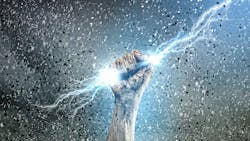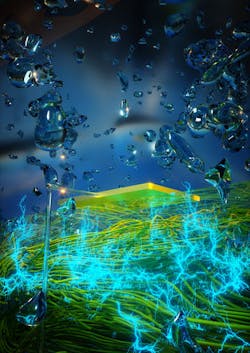Fun Innovations Friday: New Technology Generates Electricity 'Out of Thin Air'
A research team—electrical engineer Jun Yao and microbiologist Derek Lovley—at the University of Massachusetts Amherst successfully generated a small but continuous electric current from humidity in the air.
Professor Yao stated that it was actually a complete accident. “We were actually interested in making a simple sensor for humidity in the air. But for whatever reason, the student who was working on that forgot to plug in the power," says Yao.
Xiaomeng Liu, a Ph.D. student in Yao’s lab, was developing sensor devices when he noticed something unexpected. “I saw that when the nanowires were contacted with electrodes in a specific way the devices generated a current. I found that exposure to atmospheric humidity was essential and that protein nanowires adsorbed water, producing a voltage gradient across the device," he recalled.
The UMass Amherst team was surprised to find that the device, which comprised an array of microscopic tubes, or nanowires, was producing an electrical signal regardless.
Each nanowire was less than one-thousandth the diameter of a human hair, wide enough that an airborne water molecule could enter, but so narrow it would bump around inside the tube. Each bump lent the material a small charge, and as the frequency of bumps increased, one end of the tube became differently charged from the other.
“So it’s really like a battery,” says Yao. “You have a positive pull and a negative pull, and when you connect them the charge is going to flow.”
They call this device an "Air-gen" or air-powered generator with electrically conductive protein nanowires produced by the microbe Geobacter.
Lovley discovered the Geobacter microbe in the mud of the Potomac River more than 30 years ago. His lab later discovered its ability to produce electrically conductive protein nanowires. Before coming to UMass Amherst, Yao had worked for years at Harvard University, where he engineered electronic devices with silicon nanowires. They joined forces to see if useful electronic devices could be made with the protein nanowires harvested from Geobacter.
The device uses a natural protein to create electricity from moisture in the air, a new technology that they say could have significant implications for the future of renewable energy, climate change, and in the future of medicine.
The Air-gen connects electrodes to the protein nanowires in such a way that an electrical current is generated from the water vapor naturally present in the atmosphere—or known as humidity.
“We are literally making electricity out of thin air,” says Yao.
Lovely, who has advanced sustainable biology-based electronic materials over three decades, adds, “It’s the most amazing and exciting application of protein nanowires yet.”
The new technology is non-polluting, renewable, and low-cost. They've even come a long way to where the device can generate power even in areas with extremely low humidity such as a desert.
Lovely feels that it has significant advantages over other forms of renewable energy including solar and wind as the Air-gen doesn't require sunlight or wind and even works indoors. The Air-gen generates clean energy 24/7.
Requiring only a thin film of protein nanowires less than 10 microns thick, the bottom of the film rests on an electrode while a smaller electrode that covers only part of the nanowire film sits on top. The film adsorbs water vapor from the atmosphere. A combination of the electrical conductivity and surface chemistry of the protein nanowires, coupled with the fine pores between the nanowires within the film, establishes the conditions that generate an electrical current between the two electrodes.
According to the researchers, the current generation of Air-gen is able to power small electronics and they expect to bring the invention to commercial scale soon. Their next steps include developing a small Air-gen “patch” that can power electronic wearables such as health and fitness monitors and smartwatches, which would eliminate the requirement for traditional batteries. They also hope to develop Air-gens to apply to cell phones to eliminate periodic charging.
“The ultimate goal is to make large-scale systems. For example, the technology might be incorporated into wall paint that could help power your home. Or, we may develop stand-alone air-powered generators that supply electricity off the grid. Once we get to an industrial scale for wire production, I fully expect that we can make large systems that will make a major contribution to sustainable energy production," says Yao.
In addition to the Air-gen, Yao’s lab has developed several other applications with protein nanowires. “This is just the beginning of a new era of protein-based electronic devices,” said Yao.
Fun Innovations Friday
Created by the editors of New Equipment Digest and Plant Services, Fun Innovations Friday is a feel-good blog that showcases how advances in science, math, engineering, and technology are making our world more whimsical. Here’s another post that is guaranteed to brighten your day.
I Don’t Think You’re Ready for This Jellyfish-Inspired Robot That Can Clean the Ocean Floor
These enticing invertebrates might be the solution to our oceanic pollution problems.
About the Author
Laura Davis
Editor-in-Chief, New Equipment Digest
Laura Davis is the editor in chief of New Equipment Digest (NED), a brand part of the Manufacturing Group at EndeavorB2B. NED covers all products, equipment, solutions, and technology related to the broad scope of manufacturing, from mops and buckets to robots and automation. Laura has been a manufacturing product writer for eight years, knowledgeable about the ins and outs of the industry, along with what readers are looking for when wanting to learn about the latest products on the market.

